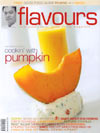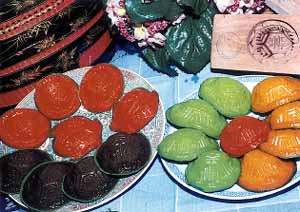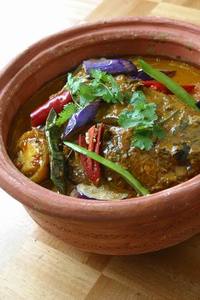$70 of Joy
 When is a magazine worth $70? It doesn’t fight “stubborn belly fat,” so how to justify the expense? The cover price works out to a mere $2.30 or so but the $54 shipping from Malaysia kills me. I love Flavours more than almost any food magazine I’ve found, despite the fact that I’ve never cooked single thing from it. My subscription just ran out and I’m going to have to bite the bullet.
When is a magazine worth $70? It doesn’t fight “stubborn belly fat,” so how to justify the expense? The cover price works out to a mere $2.30 or so but the $54 shipping from Malaysia kills me. I love Flavours more than almost any food magazine I’ve found, despite the fact that I’ve never cooked single thing from it. My subscription just ran out and I’m going to have to bite the bullet.
The writing is ok, the thing is rife with advertising/pr blurring usually reserved for small town dailies, they only recently started noting which restaurant reviews were anonymous (and vice versa), but the magazine taps into a twisty culture that I’m fascinated by. When people think Malaysia, they think quintessential street food and they’d be right. In fact, there was just a travel piece in the New York Times on the topic. I had some of the best dishes ever on my visit last year. The region’s residents are food crazy, and rightly so. Eating and obsessing on where to eat is a perfectly acceptable hobby. Makansutra had this niche pre-blog era. It’s no coincidence that many of the original food bloggers were based out of Singapore and Malaysia (I recall reading a few years back when Friendster was the big thing that after the U.S., Malaysia had the highest number of members) and they continue in their proliferation. Singaporean Chubby Hubby seems to currently have the corner on the slick, anything but amateur market.
But there’s not a lot of high-low mingling, it’s either hawker or haute. Western food frequently fills the gap in the middle. Malaysians might take offense at this, but as with many nationalities, their tastes tend to be provincial. They like what they know and are incredibly particular about minutiae like subtle differences in broth at various stalls. Yet they’re not so critical with foreign flavors. I was initially baffled how Thai food could be better in NYC than 100 miles from the Thai border. Most of what I saw tended to revolve around noodles or was something not terribly Thai dubbed tom yum (though I have to admit that tom yum pizza sounds like an awesome invention) in the way we’d stick pineapple on something and call it Hawaiian.
Flavours definitely dallies in the higher end but it is tradition-bound too. The tone is aspirational, occasionally fawning and sometimes misguided. I love the hodgepodge. Picking the January/February 2006 issue off the shelf randomly, the first ad for Maggi celebrates Chinese New Year with the tagline, “customs may change but good taste is forever,” which sums everything up. Honestly, I don’t even know what the original customs are—maybe that’s why I can enjoy how they jumble them all up.
 Content from this issue includes "The New Oriental Splendour" and pictures pretty amuse bouches of prunes & bacon with pan-fried potato and cherry tomato with Chinese bbq meat; "New Year with the Nonyas," which features old school dishes like hati babi bungkus (pork liver balls); "Old-fashioned Favourites," profiling nostalgic snacks from yesteryear like fah sang koh and ham chit soo that are completely bewildering to me; a column from a French chef who teaches at the French Culinary School in Asia on how to cook lamb, the premise being that “Malaysians do not know what to do with lamb.” The roasted lamb rack with tapenade & black olive mashed potato looks pretty good.
Content from this issue includes "The New Oriental Splendour" and pictures pretty amuse bouches of prunes & bacon with pan-fried potato and cherry tomato with Chinese bbq meat; "New Year with the Nonyas," which features old school dishes like hati babi bungkus (pork liver balls); "Old-fashioned Favourites," profiling nostalgic snacks from yesteryear like fah sang koh and ham chit soo that are completely bewildering to me; a column from a French chef who teaches at the French Culinary School in Asia on how to cook lamb, the premise being that “Malaysians do not know what to do with lamb.” The roasted lamb rack with tapenade & black olive mashed potato looks pretty good.
Then there’s an insane feature on truffles (Perigord black truffles were quoted at RM3,000 to RM4,000 per kg. Hmm, that’s $400-500 a pound, probably about right) with a recipe for truffle puffs, essentially typical curry puffs stuffed with foie gras and truffles. It’s probably tasty, despite its ostentatious premise. Not so palatable is a cocktail they’ve devised called an azur, which is a glass of Chardonnay drizzled with blue Curaçao.
They review a place called Fondue House and are sure to point out that recipes have been tweaked for local palates, many have low alcohol content or none at all, and the bacon cheese fondue uses beef bacon. Sometimes you forget when reading flashier publications that the country is predominantly Muslim. I recall being surprised that our room service breakfast at a perfectly modern hotel had a choice of beef bacon, turkey ham or chicken sausage. No pork to be found.
I’m enamored with how the mixed culture—Malay, Chinese, Indian, British, Portuguese—all put a mark on local cuisine and how this natural fusion informs how dining is interpreted. It’s a weird scene. Last year, in Kuala Lumpur, we went to Frangipani, a swanky creative restaurant, and were two of only eight diners in the vast space, all Caucasian.
 The concept hasn’t been fully embraced yet, and for good reason—it’s really freaking expensive. Our bill was around $150, more on par with a New York restaurant. Meanwhile, a bowl of laska at sit-down Madame Kwan’s goes for around $3.50, and locals complain (you can get it on the street for under one dollar). It’s like these Chinese monster malls filled with luxury goods but necessarily enough clientele. The transition is too fast and unattainable for the mainstream. (Coincidentally, there was just a related discussion on egullet about the lack of high end dining threads.)
The concept hasn’t been fully embraced yet, and for good reason—it’s really freaking expensive. Our bill was around $150, more on par with a New York restaurant. Meanwhile, a bowl of laska at sit-down Madame Kwan’s goes for around $3.50, and locals complain (you can get it on the street for under one dollar). It’s like these Chinese monster malls filled with luxury goods but necessarily enough clientele. The transition is too fast and unattainable for the mainstream. (Coincidentally, there was just a related discussion on egullet about the lack of high end dining threads.)
I know it’s strange that I don’t enjoy this type of coverage when it’s home grown. Maybe that’s because New York is oversaturated with gloss. Or maybe it’s because Flavours’s style is highly un-American. When they mix Western flourishes in, which they often do, it’s European or Australian. Nods to the U.S. are nearly non-existent (they murder Mexican food—cajun spices, gouda and baked potato with your burrito?) Sometimes it’s fun being an outsider, totally unjaded and learning everything from scratch.

 Follow
Follow




